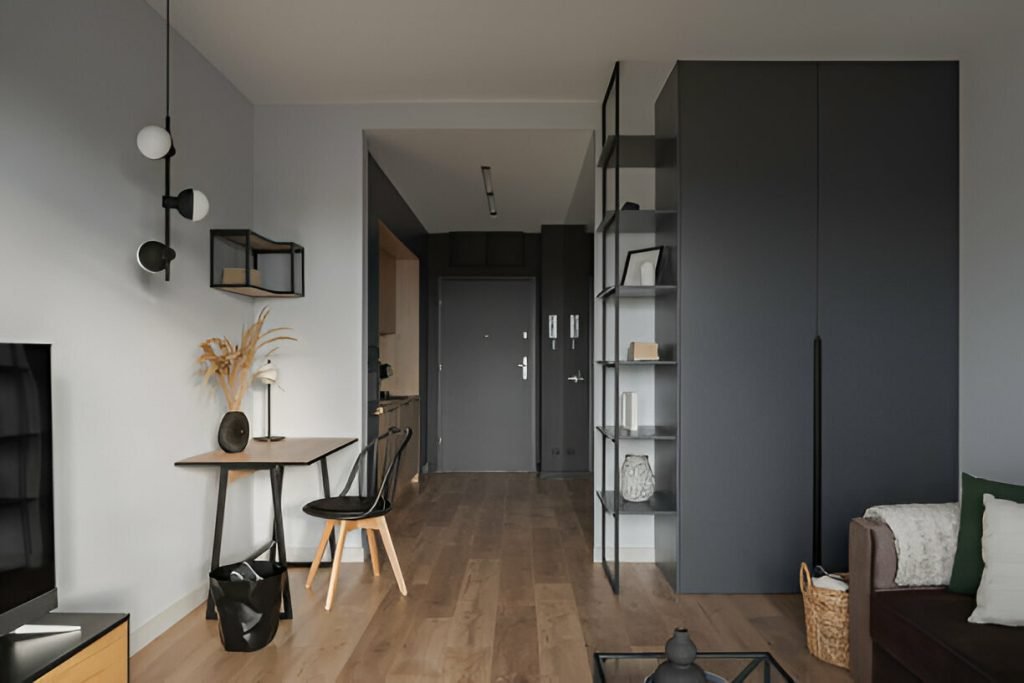Small spaces can be charming, cozy, and functional but when they feel cramped or dark, they can quickly become uncomfortable. One of the most effective ways to open up a small room visually is by choosing the right paint colors and applying smart painting techniques. With the right approach, you can transform even the tiniest room into a bright, welcoming area that feels far more spacious than it is.
At Local Painters, we specialize in helping homeowners bring out the best in their spaces, no matter the size. Whether you’re updating a small bedroom, powder room, or city apartment, these interior painting tips will help you create the illusion of openness and airiness.
1. Choose Light Paint Colors to Reflect Space
One of the simplest and most effective tricks for painting small rooms is using light paint colors. Pale shades naturally reflect more light, which helps to visually expand the space.
Recommended Light Colors:
- Soft whites and off-whites
- Pale grays
- Pastel blues and greens
- Warm beiges or creams
These shades act as room-brightening paint options, helping the room feel clean, open, and airy. Not only do they reflect more light, but they also reduce harsh contrasts, allowing the walls to recede visually.
Pro Tip: Use a satin or eggshell finish to add a slight sheen that enhances light reflection without overwhelming the eye.
2. Stick to a Monochromatic Color Scheme
Too many contrasting colors can break up a room visually, making it feel even smaller. A monochromatic palette, using different shades of a single color family, creates flow and makes the space feel unified.
This strategy works especially well when you’re working with open shelving, trim, or architectural details. Matching the paint colors for small spaces with these elements eliminates harsh breaks, creating a smooth, spacious look.
3. Paint the Ceiling the Same Color as the Walls
In many homes, the ceiling is painted stark white, which can visually chop up the room. In small rooms with low ceilings, this contrast can make the ceiling feel even lower. To counter this, consider painting the ceiling the same color as the walls, especially if you’re using a light tone.
This technique blurs the edges between wall and ceiling, creating the illusion of height and giving the space a more expansive feel. It’s one of the most overlooked but powerful visual space tricks in the painter’s toolbox.
4. Use Vertical and Horizontal Accents Wisely
Stripes and accent walls can work wonders when used strategically. Vertical stripes can draw the eye upward, making ceilings appear higher. Horizontal stripes can elongate the walls, making the room feel wider. This is especially helpful in narrow spaces like hallways or bathrooms.
For a modern twist, consider color-blocking with space-enhancing colors such as soft lavender, icy blue, or pale gray-green. Keep the contrasts subtle to maintain cohesion in the room.
5. Match the Trim to the Wall Color
Contrasting trim is a popular design choice in large spaces, but in small rooms, it can visually “frame in” the space and make it feel tighter. By painting your baseboards, crown molding, and window trim the same color as the walls, or just a half shade lighter, you allow the eye to travel freely without interruption.
This is one of the easiest small space design ideas that adds elegance and a seamless feel.
Additional Interior Painting Tips for Small Spaces
Beyond just choosing the right colors, here are a few additional suggestions to help your small room feel bigger and brighter:
Use Gloss Strategically
While you don’t want your walls overly shiny, a subtle gloss finish on the ceiling or trim can help reflect natural and artificial light, amplifying the sense of openness.
Keep Furnishings and Decor Minimal
The more cluttered a room is, the smaller it feels. Paint should enhance the architecture of the room, not compete with it.
Incorporate Mirrors and Light Fixtures
Pair your best paint for small spaces with well-placed mirrors and lighting to bounce light around the room and highlight your chosen colors.
Popular Paint Color Options for Small Rooms
If you’re unsure where to begin, here are a few tested favorites recommended by our painting experts:
- Benjamin Moore’s White Dove – A warm white that suits almost any room
- Sherwin-Williams’ Sea Salt – A soft, airy green-gray ideal for bedrooms and bathrooms
- Behr’s Silver Drop – A light neutral with a hint of gray that complements minimal interiors
- Farrow & Ball’s Pale Powder – A soft pastel blue that works well in north-facing rooms
Each of these shades is a great example of how paint colors for small spaces can be both functional and beautiful.
Why Work with Local Painters for Your Small Room Project
Painting small spaces takes more than just picking a color. It involves understanding visual space tricks, light behavior, and finish types. At Local Painters, we offer:
- Personalized interior painting tips based on your room’s shape, lighting, and purpose
- A curated selection of room-brightening paint and space-enhancing colors
- Clean, professional service tailored to the unique needs of compact spaces
- Affordable options and fast turnaround for apartments, condos, and small homes
Conclusion: Small Rooms, Big Potential
Small rooms don’t have to feel tight or dull. With thoughtful design choices, the right light paint colors, and professional application, you can make a small room look bigger and more inviting.
By choosing expert painters who understand the science of color and space, you maximize your home’s potential without major renovations.
Ready to Transform Your Small Space?
Let the experts at Local Painters help you refresh your space with color that expands, brightens, and inspires. Contact us today for a free estimate and let us help you discover the best paint for small spaces and the professional results to match.
FAQs About Painting Small Rooms to Feel Bigger
1. What are the best paint colors to make a small room look bigger?
Light shades such as soft whites, pale grays, pastels, and warm neutrals reflect more light and visually expand the space, making small rooms feel larger and brighter.
2. Should the ceiling be painted the same color as the walls in a small room?
Yes. Painting the ceiling the same light color as the walls can blur boundaries and create the illusion of height, making the room feel more spacious and unified.
3. Does glossy paint make a small room feel bigger?
A subtle satin or eggshell finish helps reflect light without too much shine. While high-gloss finishes reflect the most light, they can be overwhelming in small spaces if overused.
4. Can dark colors ever work in small rooms?
Yes, but only when used strategically. A deep accent wall or moody tone with ample lighting and minimal decor can add depth without closing in the space.
5. Why hire professional painters for a small room project?
Professionals understand how light, color, and layout interact. They ensure clean lines, proper prep, and expert recommendations to maximize space with minimal disruption.






